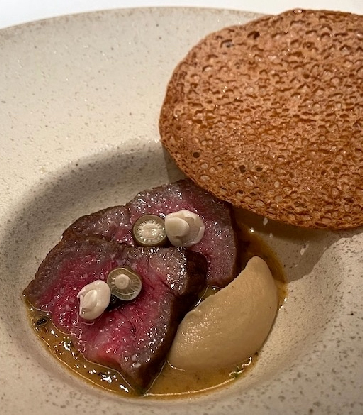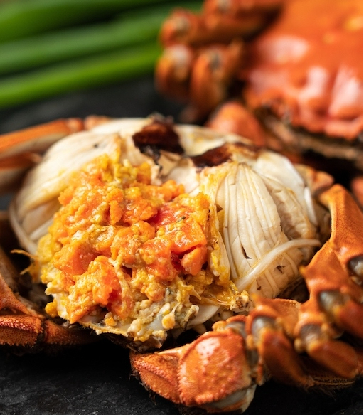History has its taste. Like every other province in Thailand, the cultural and historical narrative of Tak province, or Mueang Tak, as it’s also known locally, can be experienced through its culinary offerings. The province has a long history that dates back over 2,000 years when the Mon (or Raman) ancestors first settled along the Ping River. Historically, its neighbours comprised Burma (Myanmar), the Kingdom of Lanna, as well as the ancient Sukhothai Kingdom. It’s thus not surprising that Tak’s cuisine would reflect the crucible of culture that makes up this northern province, from the rich varieties of miang (bite-sized wraps made with edible leaves), its unique kaeng ma hae (pigeon pea curry) and curry porridge, to the town’s love for khao kriap (rice crackers).

A product of 2,000 years of acculturation, one signature cuisine from Tak is miang. Sharing a similarity to its Burmese counterpart, lapeh, or miang leaf, whose miang tea leaf features condiments wrapped in fermented tea leaf, these bite-sized wraps come in many varieties; such as, the more well-known miang kham, or the three main miang menus from Tak: miang tao chiao, miang maphrao, and miang khaep mu.
A menu that showcases Tak’s famous tao chiao, or fermented soybean sauce, is miang tao chiao. Just as its name suggests, miang tao chiao is eaten with tao chiao instead of the usual sweet miang sauce and is enjoyed with an accompaniment of ginger, lemongrass, garlic, lemon, and grated coconut with Tak fermented soybean sauce.
The snack can be eaten with bai cha phlu (wild betel leaves), or do as the locals would and enjoy it with khao kriap nga dam (crispy rice cracker with black sesame seeds). However, the way khao kriap is eaten with miang tao chiao differs from the usual method of roasting or frying khao kriap until crispy. Instead, the khao kriap dough is sprinkled with water until soft. The fillings are then put onto the khao kriap and topped with the special sweet and savoury tao chiao sauce. Some recipes may also include chilli and makhuea puang (turkey berry) to spice up the dish, while peanuts, sun-dried shrimp or khao pong (crispy rice) are used to add more texture to the bite.

The other two miang menus from Tak province are miang maphrao and miang khaep mu. The two are commonly served on a banana leaf plate, which harks back to their origin from ancient Lanna. Those who want to try miang khaep mu and miang maphrao may visit the Walking Street Weekend Market, known to the locals as Kad Nang Yong Khlong Yam, where one may enjoy the two miang variations served with bai miang - fermented tea leaves prepared by soaking the leaves in vinegar, sugar and fresh ginger root.
Miang khaep mu is enjoyed with a filling of khaep mu, a Thai name for deep-fried pork rind or pork crackling. It’s a very popular snack among the locals. While one may see the pork crackling as a condiment often eaten with different types of Thai chilli dips (nam phrik), in Tak, they are also eaten with fried peanut and crispy garlic, miang sauce, and wrapped with bai miang leaf.
Miang maphrao or coconut wraps feature crispy grated coconut flesh with fried peanut and garlic. As with the other miang variations, they’re eaten with a dollop of sweet nam miang sauce. The sweet and crispy filling is well-rounded when eaten together wrapped in bai miang (fermented tea leaf). Aside being used in miang, coconut is also popularly used in other dishes and enjoyed as snacks. It’s thus not surprising that coconuts would also have a role beyond the kitchen and dining table.

Another local specialty of Tak is kaeng ma hae or ma hae curry from Ban Tak district. Ma hae, or pigeon peas, are best enjoyed during summer around Songkran (Thai New Year). Served with fried or grilled khao kriap, kaeng ma hae is popularly enjoyed by the locals and also cooked for monks during the summer.
The curry itself consists of ma hae peas, which must be boiled for four hours to soften them, as well as protein; such as, grilled fish and pork. Other ingredients include phrik kaeng som (sour chilli paste), fish sauce, tamarind paste, cha-om leaves (climbing wattle), and som poi (Acacia concinna) leaves, which make up the curry’s flavour and aroma. For those with a penchant for curries, Tak is also known for their khao tom pong kari or curry porridge with pickled cabbage and fried minced pork with curry powder.
After a piquant treat for your palate, don’t forget to feast your eyes on the ornate temple of Wat Phra Borommathat located in Ban Tak district. It boasts a religious significance and draws in visitors to pay homage to the Buddha’s relics enshrined within the temple, as well as one of the most well-known Buddha sculptures, Luangpho Tun Chai. The architecture itself features a pagoda or chedi, which resembles the spectacular Shwedagon Pagoda in Myanmar.

Tak is rich in cultural history, with many locations ranging from temples and shrines to the Chaleoem Phrakiat Museum and the old Chinese quarter for visitors to discover. Along with these, the province also boasts fascinating culinary offerings that shouldn’t be missed.
Don’t forget to taste the different types of miang found only in Tak, as well as the ma hae curry, khao tom pong kari and other dishes featuring the province’s staple food, khao kriap.
While Loi Krathong may be a nationwide tradition, this lantern festival has its own unique streak in Tak. Loi Krathong Sai, Lai Prathip Pan Duang is a beautiful tradition where leftover coconut shells are used to make threaded floating lanterns for the Loi Krathong Festival. The coconut shells are thoroughly cleaned and filled with melted candle wax to hold the wick in place before they’re threaded. With 1,000 krathongs (lanterns) per thread, these glowing lanterns are floated in a candlelit chain down the Ping River under the full moon.

This beautiful illumination is often accompanied by dancing villagers as they follow the procession of krathongs along the riverbank. Each year, a competition is held around the Bangkok Bicentennial Bridge, known to the locals as the Hanging Bridge. Providing the best viewpoint of the Ping River in Tak, the bridge is a perfect spot for the locals to observe the competition—a krathong race where the community who can make their train of krathongs at a regular pace with their candle still lit is given a trophy.
Tak is a five-hour drive from Bangkok on the Asian Highway and can also be reached by plane. The closest ports are Sukhothai province and Mae Sot district.
Places to find recommended menu:
Miang Tao Chiao
1. Miang Khum Mueang Tak Mae Phong Phan: call 06 2362 9951
2. Ran Miang Chom Pol: call 08 7308 2874
3. Kad Nung Yong Klong Yam (Weekend evenings)
Miang Maphrao and Miang Khaep Mu
1. Kad Nang Yong Klong Yam (Weekend evenings)
Kaeng Ma Hae
1. Kad Nang Yong Klong Yam (weekend evenings)
2. Ran Wattana Hip, Ban Tak district : Reservation call 06 4165 1949
3. Ran Aiyarawadee, Mueang Tak district : Reservation call 0 5551 2419
Yam Khao Kriap
1. Kad Nung Yong Khlong Yam (weekend evenings)
2. Ran Aiyarawadee, Mueang Tak district : Reservation call 0 5551 2419
3. Ran Yam Khao Kriap Song Nari
Khao Tom Phong Kari
1. Kad Nang Yong Khlong Yam (Weekend evenings)
2. Ran Kuai Tiao Mae Mali: call 08 6737 8157 (Mornings)
This article is brought to you by the Tourism Authority of Thailand.
To know more about the Tourism Authority of Thailand, please visit https://www.tourismthailand.org/
For more information, contact the Tourism Authority of Thailand (TAT), TAK OFFICE
193 Taksin Road, Nong Luang Sub-district, Mueang district, Tak
Tel. +66 (0) 5551 4341-3
Email : tattak@tat.or.th
www.tourismthailand.org/tak or visit www.tatcontactcenter.com/en/Main, or call the TAT contact centre at 1672.





















